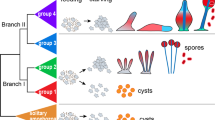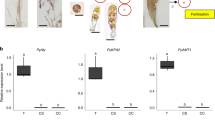Abstract
CARPOSPORES and tetraspores of G. verrucosa have been grown on microscope slides in running, natural sea water under constant illumination. After the initial attachment to the slide, divisions occur which correspond, in general, with the observations of Killian1. These produce, in 40–45 days, a dome of cells which may be 30–35µ high and 120µ in diameter. In the majority of isolated sporelings there is a great reduction in activity at this stage ; but in some cases development of the shoot begins, in circumstances described below. The peripheral growth of closely adjacent spores leads to their meeting and coalescing into irregularly shaped ‘rafts’. In these rafts individual sporelings cannot be recognized after a time unless their positions have been mapped at earlier stages. On all slides shoots have been first observed arising from rafts of this kind. Isolated sporelings, on the other hand, rarely show any change from the 40-day condition after several months, by which time coalesced sporelings of the same age have produced shoots several millimetres long. Shoots are not produced by all sporelings in a raft, and, when an extensive raft produces numerous shoots, these are well spaced out and seldom arise from adjacent sporelings. Furthermore, it will be seen from Fig. 1 that the larger rafts tend to bear proportionately longer shoots. On the slide concerned, the longest (1.8 mm.) occurred on a raft of about five sporelings. Larger rafts on the same slide bore more than one shoot, but none was longer. The largest raft, containing about fifty sporelings, bore ten shoots averaging 0.61 mm. in length, the longest measuring 1.6 mm. A ratio of five sporelings to each shoot seems usual in the larger rafts ; but the frequency of the small shoots produced on isolated sporelings is much lower than 1 in 5.
This is a preview of subscription content, access via your institution
Access options
Subscribe to this journal
Receive 51 print issues and online access
$199.00 per year
only $3.90 per issue
Buy this article
- Purchase on Springer Link
- Instant access to full article PDF
Prices may be subject to local taxes which are calculated during checkout
Similar content being viewed by others
References
Killian, K., Zeit. Bot., 6, 209 (1914).
Chemin, M. E., Rev. Gen. Bot., 49, 365 and 441 (1937).
Author information
Authors and Affiliations
Rights and permissions
About this article
Cite this article
JONES, W. Effect of Spore Coalescence on the Early Development of Gracilaria verrucosa (Hudson) Papenfuss.. Nature 178, 426–427 (1956). https://doi.org/10.1038/178426b0
Issue Date:
DOI: https://doi.org/10.1038/178426b0
This article is cited by
-
Carpospore release and sporeling development in Gracilaria gracilis (Gracilariales, Rhodophyta) from the southwestern Atlantic coast (Chubut, Argentina)
Journal of Applied Phycology (2013)
-
Carpospore early development and callus-like tissue induction of Chrysymenia wrightii (Rhodymeniaceae, Rhodophyta) under laboratory conditions
Journal of Applied Phycology (2010)
-
Effects of temperature and irradiance on early development of Chondrus ocellatus Holm (Gigartinaceae, Rhodophyta)
Chinese Journal of Oceanology and Limnology (2010)
-
Early development ofChondrus ocellatus holm (Gigartinaceae, Rhodophyta)
Chinese Journal of Oceanology and Limnology (2006)
-
New phenomenon in early development of sporelings inGracilaria asiatica Chang et Xia (Gracilariaceae, Rhodophyta)
Chinese Journal of Oceanology and Limnology (2006)
Comments
By submitting a comment you agree to abide by our Terms and Community Guidelines. If you find something abusive or that does not comply with our terms or guidelines please flag it as inappropriate.



